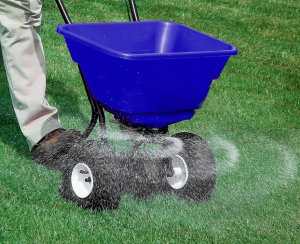With a few spring-like days recently, many of us will soon have spring fever and want to start working on our gardens and landscapes. One common question that comes to our office is, “Can I fertilize my lawn now?” Even though warmer temperatures cause people to look for things to do outside, fertilizing the lawn too early is a mistake many make.
The goal with fertilizing the lawn is to fertilize when the grass is actively growing. In late winter and early spring you may see a little bit of green in some types of warm-season grasses, but the majority of warm-season lawns are still dormant at this time. Warm-season grasses are actively growing during the summer months, thus lawns should only be fertilized during the summer months. This would also include not applying weed and feed lawn products too early in the spring as well. Since weed and feed lawn products include a fertilizer along with a herbicide, applying it would mean that you are adding fertilizer to your lawn.
The first step to fertilizing a lawn properly is to start with a soil test. Soil test boxes can be picked up from the Extension Office. A soil test will be the most accurate way to know what nutrients are in the soil and what the soil pH is. The soil test will allow you to know if you have too much or too little of a nutrient. Soil test results will provide lime and fertilizer recommendations for the type of lawn you have so you can make any necessary corrections. Once you make any corrections recommended by the soil test results, then you can follow a yearly fertilizer routine and get a soil test every two to three years to check the soil nutrients.
The soil pH for most grasses, except centipedegrass, should be between 6.5 and 7.0 for optimum nutrient availability. When growing centipedegrass, the soil pH should be around 5.5. If your soil pH is too low, according to your soil test results, lime can be applied to increase soil pH. Lime can be applied any time of the year; however, winter is the best because there is less traffic on the lawn, gentle winter rains minimize runoff, and alternate freezing and thawing help incorporate lime into the soil more quickly.
Often many lawns are fertilized too early in the spring or too late into the fall. The purpose to fertilizing a lawn in the summer is to add a fertilizer containing nitrogen to encourage green growth. Adding a fertilizer containing nitrogen at the wrong time can cause your lawn to be more susceptible to cold damage and pest problems. When to fertilize your lawn all depends on what type of grass you have.
Bermudagrass is best fertilized from May to August. Bermudagrass can receive fertilizer applications each month from May to August, but you would be setting yourself up for a lot of mowing. If you do not want to mow Bermudagrass as often, then you can apply fertilizer for only two to three months instead of four during the summer.
Centipedegrass is very different from our other warm-season lawns in that it does not like a lot of fertilizer and especially does not like a lot of nitrogen. Many people who often have problems with their centipede lawn can trace it back to over fertilizing because they don’t realize centipede is unlike other lawn types in that it does not lots of fertilizer. Your centipede lawn will do better if you avoid over fertilizing. Centipedegrass should only receive one fertilizer application in June and the application should be low in nitrogen.
The recommended time to fertilize St. Augustinegrass is to fertilize with low nitrogen rate fertilizer each month from May to August. When fertilizing Zoysiagrass, applications should be made in April, June, and August.
The last application of fertilizer for any of the warm-season grass types, is an application of potassium in August or early September which will prepare the lawn for winter by encouraging root growth and improve cold hardiness. An application of 1.5 lbs/1,000ft2 of 0-0-60 or 4.5 lbs/1,000ft2 of 0-0-22 in August will add the correct amount of potassium to the lawn.
You can contact the Wayne County NC Cooperative Extension Office to obtain helpful publications with maintenance schedules for each lawn type along with recommended amounts of fertilizer to apply to a lawn. Just remember that when warm weather finally arrives and you get that itch to get outside and fertilize your lawn, ignore that itch and wait until summer to fertilize your lawn.
Jessica Strickland is an Agriculture Extension Agent, specializing in horticulture for North Carolina Cooperative Extension in Wayne County.

(Photo Credit: Clemson Extension)

